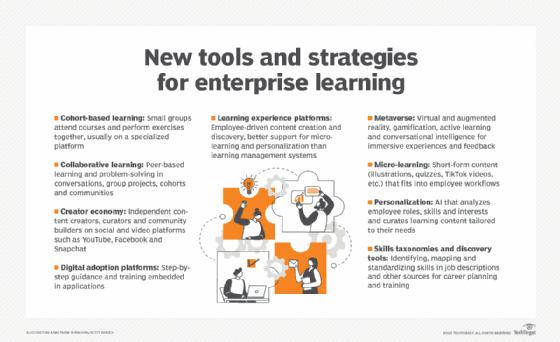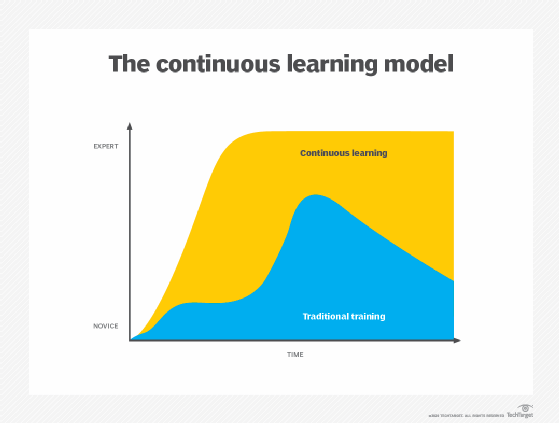employee training and development
What is employee training and development?
Employee training and development is a set of activities and programs designed to enhance the knowledge, skills and abilities of employees. It is a continuous process that aims to improve individual and organizational performance, foster career growth and adapt to evolving business needs.
Training focuses on teaching specific skills or knowledge to enhance job performance in the short term. It involves structured programs that teach employees how to perform certain tasks, use new tools or software or comply with company policies.
Development takes a broader approach, nurturing long-term growth and preparing employees for future roles and responsibilities. It includes activities such as mentoring, coaching, leadership development and personal employee growth initiatives.
Benefits of employee training and development
Investing in employee training and development is a strategic decision that positively affects both employees and organizations. By nurturing a culture of continuous learning and development, companies can reap the following rewards:
- Enhanced productivity and performance. Well-trained employees perform tasks efficiently and effectively, leading to fewer errors, improved quality and increased productivity.
- Increased employee engagement and morale. Training opportunities demonstrate that the company values employee growth, fostering job satisfaction, motivation and morale.
- Reduced turnover and increased retention of talent. Continuous learning encourages loyalty and reduces the likelihood of employees seeking opportunities elsewhere.
- Adaptability to change and innovation. Training equips employees to navigate new technologies, processes and market trends, keeping the organization competitive.
- Strengthened employer brand and reputation. Companies that prioritize employee development attract top talent and enhance their reputation as an employer of choice.
- Improved customer service and satisfaction. Well-trained employees provide exceptional service, leading to increased customer satisfaction and loyalty.
- Enhanced workplace safety and compliance. Training on safety protocols and company policies reduces the risk of accidents, noncompliance and potential legal issues.
- Promotion of knowledge sharing and collaboration. Training programs encourage knowledge sharing and collaboration, fostering a culture of teamwork and reducing employee skill gaps.
- Personal and professional growth for employees. Investing in employee development empowers individuals to enhance their skills, expand their knowledge base and advance their careers.
- Cost savings and increased profitability. Improved productivity, reduced errors and enhanced customer satisfaction contribute to overall cost savings, increased profitability and positive business impact.

Types of employee training
Employee training comes in various forms, each tailored to specific employee learning objectives and needs. The most effective employee training programs combine several methods to cater to different learning styles and ensure employees acquire the necessary knowledge and skills to excel in their roles and contribute to organizational success. Some common types of employee training include the following:
- Onboarding training. New employees start to familiarize themselves with the company's corporate culture, values and expectations through onboarding or orientation training. This introduces them to the organization's mission, vision and overall work environment.
- On-the-job training (OJT). Practical hands-on training under the guidance of experienced colleagues or supervisors, OJT provides employees with real-world experience and immediate application of skills. This method allows for personalized instruction and direct feedback.
- Safety and compliance training. This training is often mandatory and ensures that employees understand and adhere to company policies, legal regulations and industry standards. It covers topics such as workplace safety, data protection, anti-discrimination, ethical conduct, mitigating risks and ensuring compliance with legal requirements.
- Technical skills training. This type of training focuses on imparting specific job-related expertise, equipping employees with the technical know-how to perform tasks efficiently and effectively. It may encompass software training, machinery operation or other technical skills essential for the job.
- Soft skills training. This training helps develop interpersonal skills, communication techniques, teamwork, problem-solving and conflict resolution. It fosters a positive work environment and boosts overall productivity.
- Product knowledge training. An in-depth understanding of the company's products or services is important for sales, customer service and technical support teams. This training equips employees with comprehensive product knowledge, enabling them to confidently answer customer queries, resolve issues and promote sales.
- Leadership development and manager training. This training cultivates leadership skills among current and potential leaders, empowering them to guide, inspire and motivate their teams effectively. It covers topics such as communication, delegation, conflict management, decision-making and strategic thinking.
- Sales enablement training. Sales teams benefit from specialized training that hones their sales techniques, negotiation skills and customer relationship management strategies. It equips them with the tools and techniques to close deals, boost revenue and build lasting customer relationships.
- Diversity, equity and inclusion training. This training promotes a respectful and inclusive workplace culture where employees of all backgrounds feel valued and empowered. It addresses unconscious bias, cultural sensitivity and inclusive communication, fostering a diverse and equitable work environment.
- Mentoring and coaching. Personalized guidance from experienced professionals can be important for career development. Coaching and mentoring programs provide one-on-one support, tailored advice and career path guidance, helping employees reach their full potential.
- Simulations and role-playing. Interactive exercises that replicate real-world scenarios let employees practice their skills and decision-making in a low-stakes environment. Simulations and role-playing are particularly effective for customer service training, conflict-resolution training and leadership development.
- Conferences and seminars. Attending industry events, conferences and seminars exposes employees to new ideas, emerging trends and networking opportunities. It broadens their perspectives, encourages innovation and keeps them updated on industry developments.
Employee training implementation methods and trends
Employee training implementation methods and trends are constantly evolving to keep pace with the changing needs of the workforce and the advancements in technology. Today, trends demonstrate a shift toward personalized, engaging and technology-driven training experiences.
Here are some emerging approaches to implementing employee training:
- Personalization. Personalized learning tailors training content and delivery methods to individual needs and preferences. It considers learning styles, skill levels and career goals, ensuring that each employee receives the most relevant and effective training.
- Continuous learning. The concept of continuous learning emphasizes ongoing development throughout an employee's career. It encourages a culture of learning and growth, where employees are constantly acquiring new skills and knowledge to adapt to changing demands and opportunities.
- Blended learning. Blended learning combines traditional instructor-led training with digital learning and online training platforms. It allows for personalized learning paths, flexible access to content and opportunities for real-time interaction and feedback.
- Microlearning. Microlearning breaks down training content into bite-sized modules that are easy to digest and retain. This approach is particularly effective for busy employees who need quick and focused learning experiences.
- Gamification. Gamification incorporates game-like elements into training -- such as points, badges and leaderboards -- to boost engagement and motivation. It makes learning more fun and interactive, encouraging employees to actively participate and apply their knowledge.
- Mobile learning. Mobile learning uses smartphones and tablets to deliver training content anytime, anywhere. This method caters to the flexible lifestyles of today's employees, letting them learn at their own pace and convenience.
- Artificial intelligence. AI is transforming employee training by providing personalized learning recommendations, adaptive content delivery and feedback in real time. AI-powered chatbots can also act as virtual mentors, answering questions and providing support throughout the learning journey.
- Social learning. Social learning platforms encourage collaboration and knowledge sharing among employees. They provide a space for employees to ask questions, share insights and learn from each other's experiences.
- Data-driven training. Data analytics plays an important role in measuring the effectiveness of training programs. By tracking engagement metrics, completion rates and performance outcomes, organizations can identify areas for improvement and optimize their training strategies.

How to create a successful employee training and development program
To craft a successful employee training and development program, organizations should incorporate the following key elements:
- Set tangible goals. Clear and measurable objectives should be established for the training program, aligning them with organizational goals and skill requirements. Define specific outcomes, such as improved productivity, enhanced customer satisfaction and reduced error rates. Progress should be tracked toward these goals through regular assessment and feedback.
- Prioritize personalization and flexibility for employees. Companies should recognize that employees have different learning styles and preferences by offering a variety of training methods -- such as instructor-led training sessions, e-learning modules, simulations and mentoring. Flexibility in terms of training schedules and locations to accommodate individual employee needs should also be provided.
- Invest in valuable external opportunities. Organizations should encourage employees to attend industry conferences, seminars and workshops. They should also support participation in professional development programs and certifications, as well as foster networking opportunities with experts and peers.
- Provide employee incentives. Recognition and rewards should be provided for employees who actively participate in training and demonstrate skill development. This can include offering incentives for completing training programs -- such as bonuses, promotions or recognition awards. It's important for companies to create a culture that values learning and development, where employees feel appreciated for their efforts.
- Pay attention to employee feedback. Actively involve employees in the design, implementation and evaluation of training programs. Seek their feedback to ensure that training is relevant, engaging and meets their needs by using surveys, focus groups and individual interviews. Companies should then incorporate employee feedback into the improvement of training content and delivery methods.
- Continuously review and update programs and methods. Companies should regularly evaluate the effectiveness of training programs to find if they're achieving desired outcomes. By analyzing training data, they can then identify areas for improvement and make necessary adjustments. It's also important to stay updated on emerging training trends and technologies to incorporate any new and innovative approaches.







